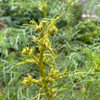Fertilizer: Micracle Gro and Osmocote
bugbite
12 years ago
Hi,
I contacted Miracle Gro (Scotts) about the PPM of Nitrogen in their Liquid fertilizer. After many back and forth emails they said the PPM in the straight liquid is about 940. I need 150 PPM 5 days a week. Their recommended dosage would be about 8 PPM every week or two. Am I in the twilight zone? What am I missing?
I then decided just to go to Osmocote 14-14-14 (still a Scott's product). You know the stuff that used to say it lasted 9 months and now says 4 months. The spec sheet below shows at 60 degrees it feeds 4 -5 months; at 70 degrees, 3-4 months; 80 degrees 2-3 months; and 90 degrees 1 to 2 months. That's not on the label...you have to download the spec sheet.
I know Osomocote performs best when the temperature rises but I did not know that in heat you have to dramatically increase the frequency of application. It just says 4 months all over the bag, but not on the spec sheet.
I wonder how that affects the amount of fertilizer the plant gets..perhaps 20% at 60 degrees and 100% at 90 degrees or is it 100% at 60 and 500% at 90 degrees. Would ask the customer service but the last answer I got from these polite folks is that Miracle Gro is not for horticulturist or professionals. Just (gullible) home gardeners like me, I guess.
Also on the 14-14-14 spec sheet, really only 12-12-12 is available. What? It's right on the spec sheet below.
Here is a link that might be useful: spec sheet



zen_man
bugbiteOriginal Author
Related Professionals
Citrus Heights Landscape Architects & Landscape Designers · Fillmore Landscape Architects & Landscape Designers · Graham Landscape Architects & Landscape Designers · Wilmington Landscape Contractors · Brookfield Landscape Contractors · Brunswick Landscape Contractors · Lake Worth Landscape Contractors · Overland Park Landscape Contractors · Salmon Creek Landscape Contractors · Aurora Driveway Installation & Maintenance · Bear Driveway Installation & Maintenance · Lebanon Decks, Patios & Outdoor Enclosures · Medford Decks, Patios & Outdoor Enclosures · Santa Ana Decks, Patios & Outdoor Enclosures · West Chester Decks, Patios & Outdoor Enclosuresken_adrian Adrian MI cold Z5
zen_man
bugbiteOriginal Author
zen_man
bugbiteOriginal Author
bugbiteOriginal Author
bugbiteOriginal Author
zen_man
zen_man
bugbiteOriginal Author
zen_man
bugbiteOriginal Author
calliope
bugbiteOriginal Author
calliope
bugbiteOriginal Author